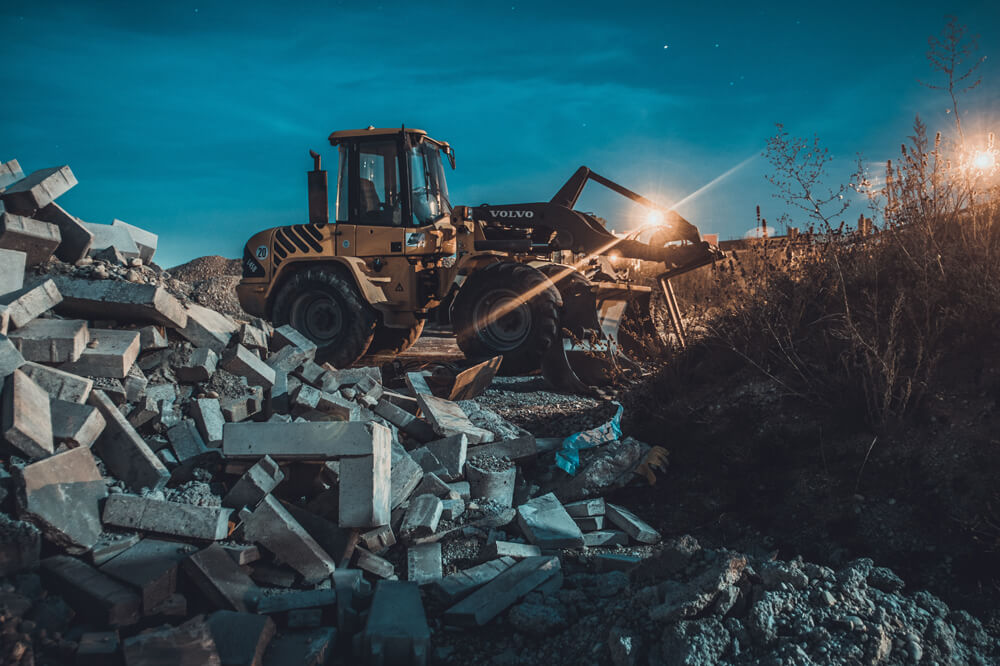A Rose Among the Rubble: Construction Rubble Removal

As our cityscapes seem to grow non-stop, it can be helpful to bear in mind that all growth comes with growing pains. One of the less obvious topics, in the context of our expanding cities, is the rubble and debris generated by construction sites. In areas where new buildings are being erected there is often an issue with the waste these sites leave behind. Dug-up soil, construction materials, rubble, and other types of garbage left behind are often not disposed of properly.
Society is becoming more conscious of the human-environmental impact of the construction industry. More and more municipalities and communities are raising the subject into the public eye. Fortunately, sustainable ways to dispose of construction rubble do exist. Read on as we explore the ways we can recycle, reuse, and remove construction rubble.
Types of Construction Rubbish
Construction waste can be a problem in many ways. First of all, dumped debris and rubble from a site is an eye-sore, bothering neighbouring homeowners and businesses and damaging the image of the community. Besides that, many types of construction waste can be hazardous to human and environmental health.
The effective management of construction site waste needs the intervention of contractor company owners and decision-makers, municipalities, governmental institutions, environmental organizations, and communities.
To put this into perspective, private and commercial construction sites generate tonnes of special waste annually, most of which cannot be disposed of like regular garbage due to its resistant nature.
While handling construction site rubble is, indeed, expensive, not handling it at all is much more costly for communities and our planet. Here are some of the most common types of construction site rubble that are being dumped:
Dirt and Soil
Dirt and soil are common by-products of excavations. Some methods of levelling an area have addressed the issue and, in some cases, the dumped soil is used to level out concave segments of the same construction area. However, this method is not viable if the soil is contaminated, or if the project demands other actions.
Garbage (human waste, packaging, used containers)
Actual garbage is often illegally dumped on construction sites, as contractors are too busy moving on to the next project to properly dispose of their own garbage, let alone someone else’s.
This results in a lot of trash around newly constructed buildings, including plastic containers and sheets, human waste, containers, and packaging, etc. These items need to be recycled when possible or disposed of properly.
Rocks and Previous Structure Rubble
When a new building is replacing an old one, the demolishing phase can leave tonnes of old rubble behind. Bricks, concrete, wood, glass, or plastic are manageable types of waste.
However, older buildings can contain asbestos, tar, lead, and other toxic materials that can’t be left around in the open. They are a danger to the inhabitants in the area, will infiltrate into the soil, and contaminate water sources.
Chemicals and Hazardous Materials
The use or presence of chemicals and hazardous materials in construction work poses a potential danger to both workers and communities. When construction rubble is not managed properly, there can be illness-inducing pollution issues and long-term effects on people and the environment.
The following is a list of some of the most common hazardous materials on a construction site:
- Solvents – a common by-product of construction or demolition sites, solvents need to be kept away from the surrounding soil and water sources. Although they are usually not present in large quantities, these types of substances must be contained and isolated when managed. The containers must be properly labelled and taken to special facilities.
- Asbestos – present in old buildings, where it was commonly used for construction, asbestos and other man-made fibres can be extremely harmful to people’s health, and nature.
- Chemicals present in waste like mercury, formaldehyde, paint thinners, paint strippers, adhesive, fluorescent bulbs and more are considered hazardous and have to be managed under strict regulations.
Usually, the workers at a construction site are the first to be affected by the improper management of hazardous construction waste. This issue trickles down to eventually impact the general public and contaminate the areas around, causing long-term effects that are very hard to manage.
Removing the Rubble the Right Way
The main challenge in managing construction site waste is transporting and storing waste. However, there needs to be a shift in how constructions are planned. Eventually, stored up refuse will start to affect all of us, even if kept in safely constructed buildings or containers. As such, construction companies need to implement a plan to reduce, reuse and recycle construction materials.
Reducing construction waste is one of the most effective ways of managing this problem, and newer technologies make it possible. It’s much easier to custom-design a house by building more modular, mobile homes, for example. This reduces waste and prevents unexpected issues.
Reusing materials whenever possible is also a crucial step in tackling this problem. There are methods of decontaminating soil that has been infiltrated with dangerous substances and reusing the earth somewhere else.
Recycling is the third step in managing construction site waste. Although expensive, it is the responsibility all construction companies have to take to secure a healthy, clean future for all of us.
How TFR Construction Can Help With Your Construction Project
In the past years, several measures have been implemented in a promising direction. Construction companies are focusing on reducing energy waste and carbon emissions. Protocols are being created and implemented for excavation work, demolishing, or construction to reduce the amount of waste we generate.
The construction and excavation work we do at TFR Construction always goes through preliminary environment assessments. We anticipate the issues that might arise when doing construction work, and we take measures to prevent most events from happening. We also use state-of-the-art equipment and machinery that work effectively and quickly, reducing the impact of our construction sites on the surrounding areas. TFR Construction specializes in rubbish removal and proper waste disposal as part of our construction site preparation. If you have any project that needs experts in our field, contact us for a no-obligation consultation today!
Recent Posts
A Parcel for the Picking – Things to Consider When Buying Land for Your Home
Selecting the proper parcel of land might be challenging but approaching the task with the correct knowledge makes it worthwhile.
Stone Landscaping: Adding Statement Stone and Boulders to Your Landscape
Stone landscaping is low maintenance, sustainable, and extremely versatile. Here is a realistic view of the main pros and cons of stone landscaping.
5 Ways to Beautify Your Sleeper Retaining Walls
In this blog post, we examine how you can combine looks and function with the latest designs of retaining walls available today.
How Sleeper Retaining Walls Can Help with Property Water Drainage Systems
We take a closer look at why retaining walls can be a fantastic solution for redirecting water around the house and protecting your foundation.
What Is a Commercial Contractor?
Contractors who work on commercial buildings have the know-how, expertise, and certifications to handle commercial construction work. But what exactly is a commercial contractor, and do you need one for your next project? Read on to find out if a commercial contractor is right for you.
Recent Posts
A Parcel for the Picking – Things to Consider When Buying Land for Your Home
Selecting the proper parcel of land might be challenging but approaching the task with the correct knowledge makes it worthwhile.
Stone Landscaping: Adding Statement Stone and Boulders to Your Landscape
Stone landscaping is low maintenance, sustainable, and extremely versatile. Here is a realistic view of the main pros and cons of stone landscaping.
5 Ways to Beautify Your Sleeper Retaining Walls
In this blog post, we examine how you can combine looks and function with the latest designs of retaining walls available today.
How Sleeper Retaining Walls Can Help with Property Water Drainage Systems
We take a closer look at why retaining walls can be a fantastic solution for redirecting water around the house and protecting your foundation.
What Is a Commercial Contractor?
Contractors who work on commercial buildings have the know-how, expertise, and certifications to handle commercial construction work. But what exactly is a commercial contractor, and do you need one for your next project? Read on to find out if a commercial contractor is right for you.





